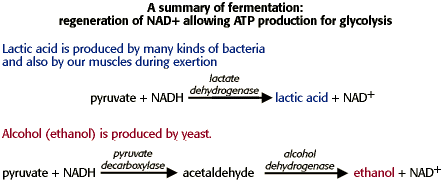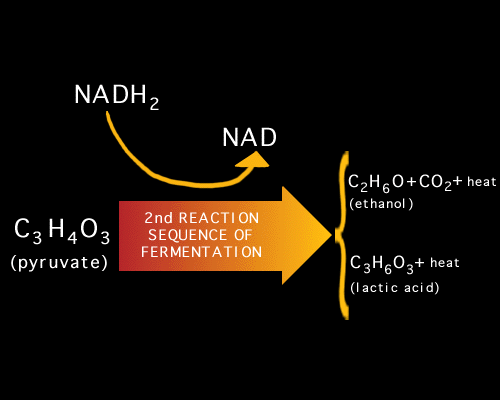|
Lactic Acid Fermentation
During glycolysis 2 pyruvate and 2 NADH+H+ are formed. With oxygen present the 2 pyruvate travel into the mitochondria to the kreb's cycle. Without oxygen lactic acid fermentation may take place. In this instance the 2 pyruvate accept the the 2 hydrogen atoms from the 2NADH+H+ to form 2 lactate. This also turns the 2NADH+H+ back into 2NAD+ which will enter back into glycolysis. This process is used to keep the pyruvate and NADH+H+ from backing up the process of respiration.
Alcohol Fermentation
Like lactic acid fermentation, alcohol fermentation starts with 2 pyruvate and 2NADH+H+. Before anything happens the 2 pyruvate release carbon dioxide forming 2 acetaldehyde. These two molecules then accept 2 hydrogen atoms from the 2NADH+H+ forming 2 ethanol. Also formed in this process are 2NAD+ which enter back into glycolysis. Like lactic acid fermentation, this process helps to keep the entire cycle from backing up due to an excess of any product of glycolysis.
|

 This diagram shows the process of alcohol fermentation. This type of fermentation is used by yeast, fungus, and some bacteria. It is commonly used to make alcoholic beverages (ie beer, hard liquor).
This diagram shows the process of alcohol fermentation. This type of fermentation is used by yeast, fungus, and some bacteria. It is commonly used to make alcoholic beverages (ie beer, hard liquor).
 This daigram is a basic overview of the two processes. It is important not to forget that these are both anaerobic processes. The main difference between the two processes is the release of carbon dioxide as the first step in alcohol fermentation. This step does not occur during lactic acid fermentation. The main function of these two processes is to help cells form ATP in the absence of oxygen.
This daigram is a basic overview of the two processes. It is important not to forget that these are both anaerobic processes. The main difference between the two processes is the release of carbon dioxide as the first step in alcohol fermentation. This step does not occur during lactic acid fermentation. The main function of these two processes is to help cells form ATP in the absence of oxygen.
|





